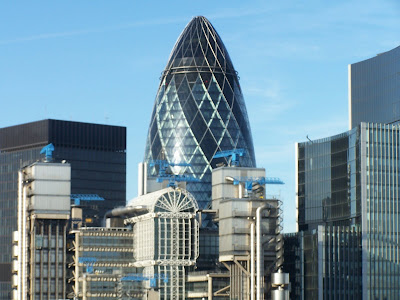

The Great Fire of London 1666 started famously in Pudding Lane. Over 100,000 Londoners lost their homes to it, yet only 6 people died!

A few years after, a budding architect called Christopher Wren ;) built Monument to the fire.

The 311 steps to the top nearly killed me! But the views from up there were absolutely worth it.
"The Monument stands at the junction of Monument Street and Fish Street Hill in the City of London. It was built between 1671 and 1677 to commemorate the Great Fire of London and to celebrate the rebuilding of the City.

The fire began in a baker's house in Pudding Lane on Sunday 2nd September 1666 and finally extinguished on Wednesday 5th September, after destroying the greater part of the City. Although there was little loss of life, the fire brought all activity to a halt, having consumed or severely damaged thousands of houses, hundreds of streets, the City's gates, public buildings, churches and St. Paul's Cathedral. The only buildings to survive in part were those built of stone, like St. Paul's and the Guildhall.

As part of the rebuilding, it was decided to erect a permanent memorial of the Great Fire near the place where it began. Sir Christopher Wren, Surveyor General to King Charles II and the architect of St. Paul's Cathedral, and hisfriend and colleague, Dr Robert Hooke, provided a design for a colossal Doric column in the antique tradition. They drew up plans for a column containing a cantilevered stone staircase of 311 steps leading to a viewing platform. This was surmounted by a drum and a copper urn from which flames emerged, symbolising the Great Fire. The Monument, as it came to be called, is 61 metres high (202 feet) - the exact distance between it and the site in Pudding Lane where the fire began.

The column was completed in 1677, and in accordance with Wren's original intention, was at first used as a place for certain experiments of the Royal Society, but vibrations caused by ceaseless traffic proved too great for the success of these experiments and they were discontinued; thereafter the Monument became a place of historic interest, unique of its kind, providing visitors with an opportunity to look across London in all directions from a height of about 160 feet, being the level of the public gallery."






No comments:
Post a Comment